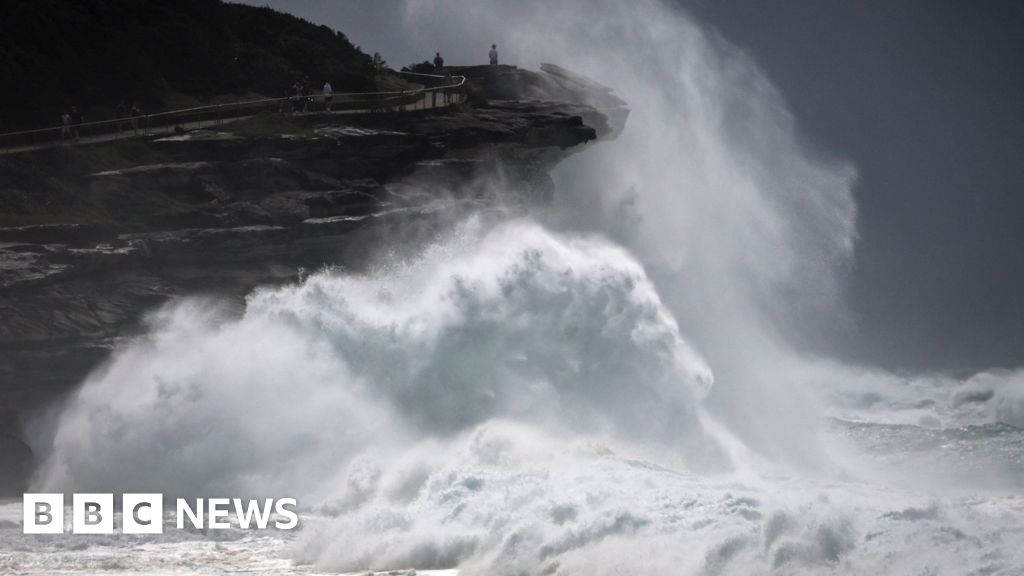Sydney's Bondi Beach: Swells Smash Coastal Windows
Editor’s Note: Large swells have battered Sydney's iconic Bondi Beach, causing significant damage to coastal properties. This article details the impact and provides insights into the ongoing situation.
Why This Matters
Bondi Beach, a globally recognized symbol of Australian tourism and lifestyle, faced significant damage from unusually large swells this week. This event highlights the increasing vulnerability of coastal communities to extreme weather events driven by climate change. Understanding the impacts of these swells—on infrastructure, businesses, and the environment—is crucial for future mitigation strategies and coastal protection planning. This article will explore the extent of the damage, the causes of the large swells, and the implications for the future of Bondi Beach and similar coastal areas.
Key Takeaways
| Point | Summary |
|---|---|
| Damage Extent | Significant window damage reported across multiple beachfront properties. |
| Cause of Swells | A combination of strong winds and a high-pressure system intensified waves. |
| Economic Impact | Businesses face losses due to damage and potential temporary closures. |
| Environmental Impact | Coastal erosion and potential damage to marine ecosystems. |
| Future Implications | Increased need for coastal protection measures and climate change adaptation. |
Bondi Beach: Swells Unleash Havoc
Bondi Beach, renowned for its stunning beauty and consistent surf, found itself on the receiving end of a powerful wave assault. The unusually large swells, peaking at [insert height of swells here], slammed into the beachfront, shattering windows of numerous cafes, shops, and residential buildings. Videos and photos circulating on social media show the dramatic force of the waves as they crashed over seawalls and onto pavements. This unprecedented event underscores the inherent risks associated with building close to the coast and the need for more resilient infrastructure.
Key Aspects of the Bondi Beach Swell Event
- Intensity of the Swells: The sheer power of the swells was unprecedented for this time of year, exceeding typical wave heights by a significant margin.
- Geographic Impact: The damage was concentrated along the eastern section of Bondi Beach, where buildings are closest to the shoreline.
- Property Damage: The most visible impact was the extensive damage to glass windows, requiring immediate repairs and significant financial losses for businesses.
- Safety Concerns: Authorities issued warnings advising people to stay away from the beach during the peak of the swell event.
Detailed Analysis of the Damage
The damage extends beyond just broken windows. Preliminary assessments suggest potential structural damage to some buildings requiring further inspection. The cost of repairs is expected to run into the [insert estimated cost here], affecting businesses already struggling to recover from the pandemic's economic impact. Furthermore, the clean-up operation is ongoing, with debris scattered across the beach and surrounding areas. Early estimates for clean up are between [insert estimated cost here].
Interactive Elements
The Role of Climate Change
Introduction: The increased frequency and intensity of extreme weather events, like the Bondi Beach swells, are linked to climate change.
Facets: Rising sea levels, more powerful storms, and changing weather patterns all contribute to larger and more frequent extreme wave events. The risk for coastal erosion is amplified. Mitigation strategies include investing in seawalls and other coastal protection measures and implementing stricter building codes. The impacts extend beyond property damage to include ecosystem disruption and tourism revenue losses.
Impacts on Local Businesses
Introduction: The economic implications of the swell event are substantial for Bondi Beach's thriving tourism industry.
Further Analysis: Cafes, restaurants, and shops sustained damage, leading to temporary closures. This impacts their revenue streams and employee livelihoods. Insurance claims will need to be processed, adding to the overall economic burden. The prolonged recovery period could significantly affect the upcoming tourist season. Closing: The event underscores the vulnerability of coastal economies to extreme weather and highlights the need for robust contingency planning.
People Also Ask (NLP-Friendly Answers)
Q1: What is the cause of the large swells at Bondi Beach?
A: A combination of strong winds and a high-pressure system created unusually large waves.
Q2: Why is this event significant?
A: It demonstrates the increasing vulnerability of coastal areas to extreme weather events and the potential for significant economic and environmental damage.
Q3: How can I help?
A: Support local businesses by visiting and purchasing from them once they reopen.
Q4: What are the long-term implications?
A: It highlights the need for improved coastal protection measures and climate change adaptation strategies.
Q5: What safety measures were in place?
A: Authorities issued warnings and advised people to stay away from the beach during the peak of the swell event.
Practical Tips for Coastal Safety
Introduction: Staying safe near the coast during extreme weather is crucial.
Tips:
- Heed Warnings: Always follow warnings issued by lifeguards and authorities.
- Check Forecasts: Monitor weather forecasts before heading to the beach.
- Avoid Risky Areas: Stay away from exposed areas during large swells.
- Be Aware of Currents: Understand the risks associated with rip currents.
- Have an Escape Plan: Know where to go in case of emergencies.
- Secure Property: Take steps to protect your property from strong winds and waves.
Summary: Prioritizing safety near the coast during extreme weather is essential for avoiding accidents and property damage.
Transition: The events at Bondi Beach highlight the need for increased preparedness and awareness.
Summary (Zusammenfassung)
The large swells that hit Bondi Beach caused significant damage to coastal properties, highlighting the risks associated with extreme weather events. The event emphasizes the importance of preparedness, mitigation strategies, and adaptation measures in response to climate change.
Closing Message (Schlussbotschaft)
The destruction at Bondi Beach serves as a stark reminder of nature's power and the vulnerability of coastal communities. What steps can we take, individually and collectively, to better prepare for future extreme weather events?
Call to Action (CTA)
Share this article to raise awareness about the impacts of extreme weather and the need for coastal protection. Sign up for our newsletter for updates on related news and safety information.

